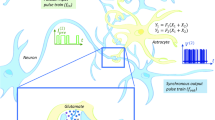Abstract
Astrocytes, also described as astroglia, are characteristic star-shaped glial cells in the brain. The important roles of astrocyte such as extracellular regulation, synaptic information regulation, neuronal synchronization and feedback to neural activity, makes the astrocytes play a vital role in the brain disease. This paper investigates the neuron–astrocyte interaction system for evaluating the network behaviors. In this approach, two basic systems are presented for considering the astrocyte controlling effects on desynchronization of the neurons spiking activity. Simulation results proved that by proper selection of the astrocyte coupling parameters in the proposed network, the networking behaviors can be modulated. As a result, when these coupling parameters have suitable values, the neurons behavior in the sample system will be controlled.




Similar content being viewed by others
References
Haghiri, S., Ahmadi, A., & Saif, M. (2017). Complete neuron–astrocyte interaction model: digital multiplierless design and networking mechanism. IEEE Transactions on Biomedical Circuits and Systems, 11(1), 117–127.
Haghiri, S., Ahmadi, A., & Saif, M. (2016). VLSI implementable neuron–astrocyte control mechanism. Neurocomputing, 214, 280–296.
Haghiri, S., & Ahmadi, A. (2020). Digital FPGA implementation of spontaneous astrocyte signalling. International Journal of Circuit Theory and Applications,. https://doi.org/10.1002/cta.2745.
Haghiri, S., Ahmadi, A., Nouri, M., & Hiedarpur, M. (2014). An investigation on neuroglial Interaction effect on Izhikevich neuron behaviour. In 22nd Iranian Conference on Electrical Engineering (ICEE), pp. 88–92.
Oberheim, N. A., Wang, X., Goldman, S., & Nedergaard, M. (2006). Astrocytic complexity distinguishes the human brain. Trends Neuroscience, 29(10), 547553.
Angulo, M. C., Kozlov, A., Charpak, S., & Audinat, E. (2004). Glutamate released from glial cells synchronizes neuronal activity in the hippocampus. Journal of Neuroscience, 24(31), 6920–6927.
Hayati, M., Nouri, M., Haghiri, S., & Abbott. D. (2015). A digital realization of astrocyte and neural glial interactions. http://doi.org/10.1109/TBCAS.2015.2450837.
Nazari, S., Faez, K., Karami, E., & Amiri, M. (2014). A digital neurmorphic circuit for a simplified model of astrocyte dynamics. Neuroscience Letters, 582, 21–26.
Nazari, S., Amiri, M., Faez, K., & Amiri, M. (2015). Multiplier-less digital implementation of neuron–astrocyte signalling on FPGA. Neurocomputing.
Nazari, S., Faez, K., Amiri, M., & Karami, E. (2015). A digital implementation of neuron–astrocyte interaction for neuromorphic applications. Neural Networks, 66, 79–90.
Postnov, D. E., Ryazanov, L. S., & Sosnovtsev, O. V. (2007). Functional modeling of neural-glial interaction. BioSystems, 89, 8491.
Nadkarni, S., & Jung, P. (2004). Dressed neurons: Modeling neural-glial interactions. Physics Biology, 1(1–2), 35–41.
Postnov, D. E., Koreshkov, R. N., Brazhe, N. A., Brazhe, A. R., & Sosnovtseva, O. V. (2009). Dynamical patterns of calcium signaling in a functional model of neuron–astrocyte networks. Journal of Biological Physics, 35, 425–445.
Izhikevich, E. M. (2003). Simple model of spiking neurons. IEEE Transactions of Neural Network, 14(6), 1569–1572.
Izhikevich, E. M. (2006). Dynamical systems in neuroscience: The geometry of excitability and bursting. Computational neuroscience. Cam-bridge. MA: MIT Press.
Kopell, N., Ermentrout, G. B., Whittington, M. A., & Traub, R. D. (2000). Gamma rhythms and beta rhythms have different synchronization properties. In Proceedings of National Academy Science, USA 97, 1867–1872.
Amiri, M., Nazari, S., & Janahmadi, M. (2018). Digital configuration of astrocyte stimulation as a new technique to strengthen the impaired astrocytes in the tripartite synapse network. Journal of Computational Electronics, 17(3), 1382–1398.
Heidarpur, M., Khosravifar, P., Ahmadi, A., & Ahmadi, M. (2020). CORDIC-Astrocyte: Tripartite glutamate-\(IP3-Ca^{2+}\) interaction dynamics on FPGA. IEEE Transactions of Biomedical Circuits System, 14(1), 36–47.
Heidarpur, M., Ahmadi, A., & Ahmadi, M. (2019). Digital implementation of a biological-plausible model for astrocyte \(Ca^{2+}\) oscillations. Journal of Computational Electronics, pp. 857–868.
Acknowledgements
Authors would like to acknowledge the financial support of Kermanshah University of Technology for this research under Grant No. S/P/T/1405.
Author information
Authors and Affiliations
Corresponding author
Additional information
Publisher's Note
Springer Nature remains neutral with regard to jurisdictional claims in published maps and institutional affiliations.
Rights and permissions
About this article
Cite this article
Haghiri, S., Ahmadi, A. An investigation on neuron–astrocyte interaction system: network behavior and synchronization. Analog Integr Circ Sig Process 108, 569–576 (2021). https://doi.org/10.1007/s10470-020-01735-5
Received:
Revised:
Accepted:
Published:
Issue Date:
DOI: https://doi.org/10.1007/s10470-020-01735-5




